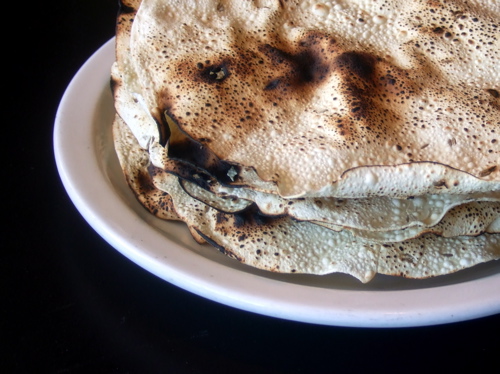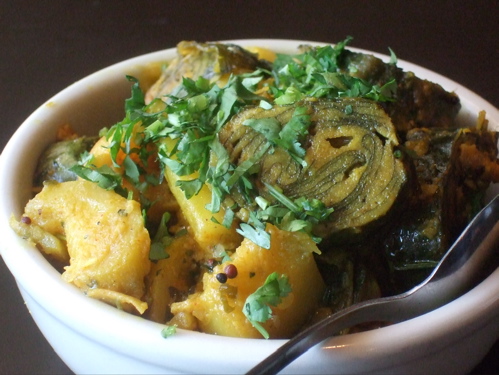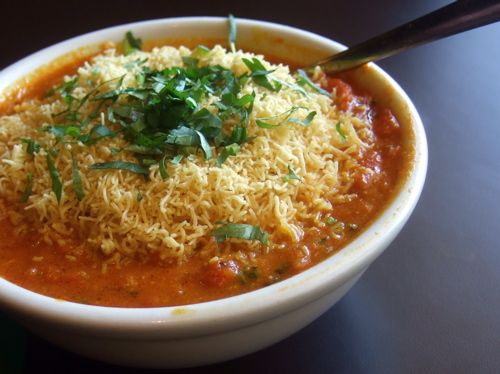| « Wasabi Apple Roll | Thursday Quick Links » |
Feature Thu Jul 26 2007
Eating Jain
[Note: a version of this story can be heard on Chicago Public Radio's 848, 91.5 FM, July 27, 2007]
Jainism is one of the world’s oldest and smallest religions. Though it started about the same time as Buddhism, there are in India only 4 million or so practitioners of this peaceful, militantly vegetarian faith.
Last Saturday, the Culinary Historians of Chicago sponsored a Jain lunch at Village Hut in Glendale Heights. I pulled up a chair.
Around the table, people were eating crepe-like rolls of griddled chick pea flour called “khandvi,” remarkably tender and subtly flavored, each sheet delicately separating on the tongue and satisfying with simple textures. Another favorite was the walnut “halwa,” a rich mixture of ground nuts, oil, and brown sugar, one of several sweet dishes, accompanied by green and red sauces packing some serious heat.
Now, that may sound a little like a regular Indian meal, but Jains eat differently. Colleen Sen is researching the cuisine of Jainism, a faith that builds upon the fundamental principle that one should always avoid doing harm to anyone or anything. She told me that, “There are five things that all Jains don’t eat, and the five are meat, fish, eggs, honey and alcohol. Then there’s a second level of foods, that are not condoned, and people who are strict, and people who are more religious won’t eat, but many people who are Jains will eat, and those foods include these categories: fruits and vegetables with many seeds, such as figs, pomegranates and tomatoes, vegetables that grow underground including potatoes, turnips, squashes, carrots, mushrooms, onions and garlic.”
Even stricter than vegetarianism, Jain cuisine is based on the belief that while eating meat obviously harms the animal that gave up its haunch for our stew, eating potatoes and other root vegetables also harms life. Why? Because the harvesting process destroys the entire plant as well as the creatures that live in and around it.
Collen explained, “Jains cannot be farmers because if you’re a farmer, you dig up the soil and what are you doing? You’re killing animals; you’re killing living things; you’re killing bugs.”
Urmila Talsania, a life-long Jain, contends that it’s relatively easy to do without most forbidden foods: “I was born in a Jain family, raised Jain way, and things you never knew, you never miss it either, so I never missed any of the chicken or meat.”
Sidney Jain, despite his name, has a slightly different story. Though born of Jain parents, Sidney was raised on all-American meat. He told me this story:
I was born into a Jain family, both my parents were vegetarian, born in the US, and maybe not having that cultural network way back in the 70s, that is here now, my parents were a little confused as to how to raise a Jain kid in the US, and all of their friends who are, you know, Caucasian Americans they said, feed your kid meat, he’ll grow up big and strong, if you don’t feed him meat, he’ll grow up sick. And so fearing that I would get sick or not grow up big and strong, my parents right from birth, my first solid food was meat. And I ate meat until I was about 14.”
Then Sidney changed his diet and began to consume rice and vegetables. For protein, he ate legumes; for calcium, dairy products, which would be avoided in, for instance, your average Vegan diet. He told me, “… our Jain Society of Metropolitan Chicago at that time was hosting what we call a declamation, which is a speech contest, which a lot of kids would give, and there was a cash prize. And you know, at the time I thought well, I can speak publicly and I’d like to enter the contest and win the money. However, at the time I was eating meat and the topic was “Vegetarianism and Ahimsa,” ahimsa being nonviolence, and the thought was how could I give a talk on vegetarianism and ahimsa when I eat meat. So, you know, being a typical 14 year old I thought, okay, I’ll be a vegetarian, I’ll give the speech, hopefully win the money, and then eventually eat meat again. I would go to lunch with my friends in high school in the cafeteria, and instead of getting a hamburger, I’d now be getting the grilled cheese, and my friends were like “Hey, what’s going on?” And I told them I was a vegetarian, and they started laughing and poking fun at me, and they were saying “Oh yeah, that will only last a month,” and I’d be eating hamburgers by the end of the year. So I’d sort of have to argue with them, and sort of debate with them about why I was a vegetarian, and so through the next year of debating with my friends as to the reasons why I was a vegetarian became much stronger. “
Having a stricter diet than even your average vegetarian makes it difficult to determine not only what you should put in your body, but what you should wear on it. For Falguni Doshi, another Jain by birth, the restrictions of her faith present daily dilemmas – some of which have nothing to do with food. Falguni explains, “Even when you think about clothes, if you’re buying your shoes, they’re probably, some of them may have leather, and a lot of people try to avoid it. If I can, I try to avoid it, but sometimes the nicer shoes or the nicer purses will have leather, and I guess…Jainism is a philosophy, and you follow it to the extent you want to follow it.”
Jainism is tolerant. It provides wiggle room for the conscience, an opening for the individual interpretation of tenets, a way to shape the faith to meet the dietary demands – and desires – of our material world.
At lunch, there’s an unmistakable blast of garlic coming from one of those spicy sauces. The stinking rose is, of course, forbidden by the strict Jain diet. It’s on the table because people like it. Accommodations such as these are fundamental to Jainism. To live a purely Jain life, to avoid injury to everything, would preclude even drinking water, which contains microscopic organisms. So allowances are accepted; exceptions, made.
Urmila explains that recognizing one’s limitations is part of what it means to eat Jain: “Jainism allows that you go only as far as you want to go in terms of practicing your Jainism. So, it’s spiritual levels, it’s a ladder, and as you go into higher levels of spirituality, you automatically don’t eat certain foods. I’m not at that level of my spirituality, so I do eat the rooted vegetables and the food with the more seeds. I am not that strong.”
Perhaps the Jain diet can become second nature…but it won’t be easy.
Walk into any grocery store and admire the fish flown in from either ocean, exotic fruits and veggies trucked up from Latin America and new foods presenting themselves to our eyes every time we shop. Human beings have never had more food options; the menu has never been so vast; and with the range of tempting food options laid before us at markets and restaurants, it seems more difficult than ever to relinquish our position at the top of the food chain.




Photos courtesy of Peter Engler









Uttam K. Jain / August 1, 2007 11:38 AM
The last prophet of Jainism, Lord Mahavir was a contemporary of Gautam Siddharth Buddha. This goes back to 600 BC. However, Jainism is much older than. There are recordings in Hindu Vaidas and Upnishads about Jain prophets dating as far back as 5000 years.